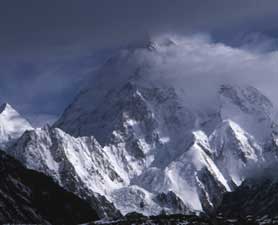
Throughout much of the Tibetan Plateau, high-altitude glaciers are dwindling in the face of rising temperatures. The situation is potentially dire for the hundreds of millions of people living in China, India and throughout southeast Asia who depend on the glaciers for their water supply.
But in the rugged western corner of the plateau, the story is different, according to a new study. Among legendary peaks of Mt. Everest like K2 and Nanga Parbat, glaciers with a penthouse view of the world are growing, and have been for almost three decades.
"These are the biggest mid-latitude glaciers in the world," John Shroder of the University of Nebraska-Omaha said. "And all of them are either holding still, or advancing."
When Shroder and a team of researchers examined satellite imagery of the region's glaciers dating back to 1960, they found that 87 glaciers had surged forward during that time, sliding down into lower elevations. An analysis of gravity signatures in the region also suggests the glaciers are growing in mass, and have been since at least 1980.
The team's work will be published in a forthcoming issue of Annals of Glaciology.
Surging glaciers are common and do not necessarily mean a glacier is growing in overall size. But the fact that dozens of them have all surged in the same region hints that larger climate forces are at work.
"It looks like it's the Westerlies," Shroder said, referring to strong jets of wind that pour from west to east in a belt around the planet. Though he can't say for certain, the winds appear to be carrying more moisture from the warming Atlantic Ocean and Mediterranean Sea eastward.
If that's true, some of the moisture would fall into the region around the Caspian Sea. But as the winds rise into Karakoram's frigid heights, any remaining water would come down as snow, feeding the glaciers.
"We will see regional patterns like this developing as climate change alters precipitation," said Andrew Fountain of Portland State University in Oregon.
Fountain said that similar trends were evident in some Scandinavian glaciers during the 1990s, which benefited from increased storminess and precipitation coming off the North Atlantic Ocean. Researchers have also found that glaciers on California's Mt. Shasta have been growing for decades. And glacier recession has been blunted in the mountains of Oregon and Washington state because of increased moisture from the warming Pacific Ocean.
In the Karakorams, the uptick in glacier mass has come with a welcomed perk. The mighty Indus River, which flows out of China and nourishes northern India and much of Pakistan has experienced an increase in discharge.
But it's not likely to last.
"As temperatures continue increasing, they will overtake additional mass provided by snow," Fountain said. "The freezing level will keep rising, and glaciers will melt."



Reader Comments
to our Newsletter